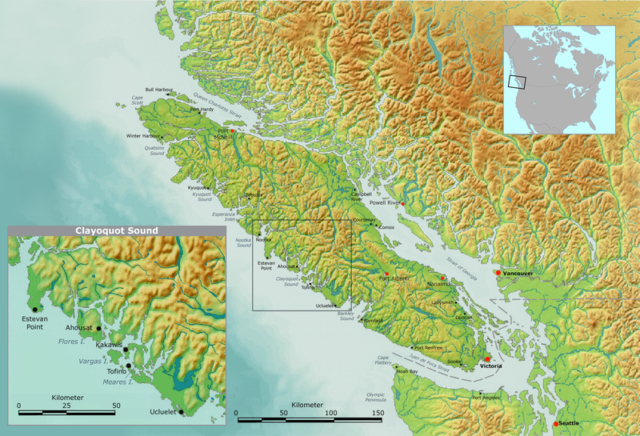The Pacific Northwest’s rocky coast is a site where remains of old shipwrecks rest below the water by the thousands. It is a shipwreck explorer’s dream. Each shipwreck hunter may have their own Holy Grail – the ship they dream of finding. Here there are many possibilities.
At Willapa Bay in southwest Washington State, the Wandering Wreck of Washaway Beach can be found – sometimes. The giant skeleton of the ship is easily explored when it rests on the sand, but now and again it floats out to sea. The wooden beams that framed the ship’s hull measure 18 inches square and are connected by iron spikes. The weight alone makes the wreck’s ability to float away remarkable.
According to the Westport Maritime Museum, the wreck was a coastal freighter that first emerged from the sand in 2009 near the town of Tokeland, Washington. The 100-foot-long hull frame has floated away and come back various times. The tendency of the wreck to move increases its chances of sustaining damage, but the owner, the Washington State Department of Natural Resources, shows no interest in preserving the bones of the old ship.

The ship has yet to be identified by name, but according to Westport South Beach Historical Society Executive Director John Shaw, the possibilities have been narrowed down to one of two ships that beached near to each other early in the 1900s. Shaw said the identity of the wandering shipwreck has been narrowed down to either the Avalon, a late 19th or early 20th-century lumber schooner, or the Trinidad, a sailing schooner later converted to steam power. Positive proof may be impossible because of the scarcity of available information to compare with the partially-burned hull. The nonprofit Maritime Archaeological Society organized a meeting with maritime history experts and shipwreck hunters to brainstorm ideas of how to proceed.
Locating one particular merchant ship owned by New York millionaire John Jacob Astor’s American Fur Company is the personal quest of scuba diver Tom Beasley of Vancouver, Canada. In 1811 the Tonquin carried fur traders to build Fort Astoria, one of the first permanent American settlements along the upper Pacific coast. After the fort was up and running, Captain Jonathan Thorn sailed the Tonquin up the coast to trade with the local natives. During a stop at Vancouver Island, the captain insulted a native chief, which set off a battle in which most of the crew lost their lives. A survivor made his way to the ship’s powder magazine and destroyed the ship.

Beasley believes the explosion occurred near a bay northwest of Port Hardy, British Columbia, or present-day Tofino. The Tofino area may have shifting sand that would cause the deep ocean waves to cover and uncover the remains of the ship every few years.
In 2003, after many years of searching, an old anchor was brought up in Tofino in 2003; up to this point, it is the most promising clue found to the ship’s fate. Beasley remarked that the anchor was coated with the blue-green beads used for trade at the time the Tonquin was burnt. Unfortunately, no markings on the anchor can positively confirm an association with the old trading vessel.
Olympia, Washington is home to archaeologist Scott Williams – his Holy Grail of shipwrecks is the Santo Christo de Burgos, a Spanish galleon lost in 1693 near Nahalemis Bay. The “Beeswax Wreck” was so named because of the wax blocks that washed up along the northern Oregon coast in the 1800s. Native Americans attempted to use them in trade. Patterned shards of porcelain also litter the beach in the area. The enormous ship accommodated about 600 men, stood about six decks high, had a length of 150 feet, and weighed up to 2,000 tons.
Williams, the primary investigator on the Beeswax Wreck Project, assembled a search team in 2006. The team plans to install an offshore magnetometer near Manzanita in Marin County — underwater magnetic anomalies help pinpoint shipwrecks for researchers. “We think the lower part of the hull is still intact somewhere offshore and that’s what we’re hoping to find,” Williams said. He stated he would be very excited to find a coin or other artifact with a date on it, to identify the ship through records. Williams has assured everyone he is not interested in earning profits from this endeavor, and anything he finds belongs to the State of Oregon.
The Santo Cristo de Burgos galleon foundered off the coast of northern Oregon while taking part in the Manila Trade, a trans-Pacific shipping route that operated between Spanish holdings in the Philippines and Mexico. It may have sunk during a storm, but no one knows exactly what the circumstances were.

The magnetometer survey technique is scheduled for an additional underwater search this summer. The secret research was code-named the Wildcat Project. Members are believed to be looking for a small sidewheeler steamboat that ran the first scheduled steamboat service on Puget Sound. It’s thought that the boat sank somewhere in the southern part of the Sound during the late 19th century, OPB News reported.
Because the policy of Presumption of Public Ownership covers most of the Northwest coast, new search expeditions are becoming more difficult to organize. There is no ability to repay investors who could sponsor a private salvage expedition, and few researchers have the means to fund it themselves.
